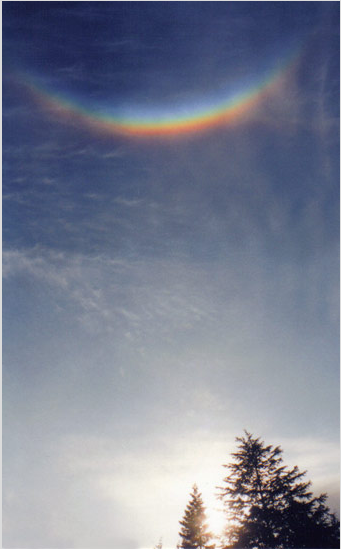Circumzenithal Arc, BC, Canada
Circumzenithal Arc, BC, Canada: A Stunning Atmospheric Phenomenon
The Circumzenithal Arc is a mesmerizing atmospheric optical phenomenon that occurs when sunlight interacts with ice crystals in the atmosphere. This captivating arc, also known as the "upside-down rainbow," was captured by Taavi Babcock on May 16, 2001, in Sooke, located on the southern tip of Vancouver Island, British Columbia, Canada. The image beautifully showcases the arc's vibrant and pure colors, which are a result of the refraction and dispersion of near-parallel sunlight through oriented plate crystals.
The purity of the colors observed in the Circumzenithal Arc is one of its distinguishing features. Unlike a traditional rainbow, which is formed by the refraction and reflection of sunlight through raindrops, the Circumzenithal Arc is created by the interaction of sunlight with ice crystals. These ice crystals act as tiny prisms, bending and separating sunlight into its component colors. Due to the specific orientation of the ice crystals required for the formation of this arc, the colors appear more vivid and saturated compared to those seen in a rainbow.
The Circumzenithal Arc is a relatively rare phenomenon that typically occurs in regions with cold climates. It is most commonly observed when the sun is relatively low in the sky, typically between 22 and 32 degrees above the horizon. The arc forms at an angle of approximately 46 degrees from the zenith, hence its name. The optimal conditions for its formation include the presence of high-altitude cirrus clouds composed of ice crystals with a particular shape and orientation.
The exact mechanism behind the formation of the Circumzenithal Arc involves complex interactions between light and ice crystals. When sunlight passes through an ice crystal, it undergoes refraction, bending at different angles depending on its wavelength. This refraction causes the sunlight to separate into its constituent colors. The ice crystals responsible for the arc's formation are typically plate-shaped, with flat faces parallel to the ground. These crystals align themselves in the atmosphere, creating a favorable environment for the arc to appear.
The vibrant colors displayed in the Circumzenithal Arc are a result of the dispersion of sunlight by the ice crystals. Dispersion refers to the phenomenon where different wavelengths of light separate and spread out. As sunlight passes through the ice crystals, shorter wavelengths, such as blue and violet, are bent more than longer wavelengths, like red and orange. This separation of colors results in a stunning display of vibrant hues, with blue on the inner edge of the arc and red on the outer edge.
It is important to note that the Circumzenithal Arc is just one of many atmospheric optical phenomena that can occur. Other related phenomena include halos, sundogs, and the more common rainbow. Each of these phenomena has its unique characteristics and formation mechanisms, making them fascinating subjects for study and observation.
In conclusion, the Circumzenithal Arc is a captivating atmospheric optical phenomenon that occurs when sunlight interacts with oriented plate ice crystals in the atmosphere. Its vibrant and pure colors make it a breathtaking sight to behold. Although relatively rare, this phenomenon can be observed in regions with cold climates, typically when the sun is relatively low in the sky. Understanding the science behind these atmospheric optics phenomena enhances our appreciation for the beauty and complexity of nature's wonders.

This intense and colourful arc was seen by Taavi Babcock at Sooke on the southern tip of Vancouver Island, British Columbia, Canada in May 16, 2001.
Taavi's image nicely shows the purity of the arc's colours. The refraction and dispersion of near parallel sunlight through oriented plate crystals produces purer colours than those of a rainbow.
�2001 Taavi Babcock, shown with permission
Note: this article has been automatically converted from the old site and may not appear as intended. You can find the original article here.
Reference Atmospheric Optics
If you use any of the definitions, information, or data presented on Atmospheric Optics, please copy the link or reference below to properly credit us as the reference source. Thank you!
-
<a href="https://atoptics.co.uk/blog/circumzenithal-arc-bc-canada/">Circumzenithal Arc, BC, Canada</a>
-
"Circumzenithal Arc, BC, Canada". Atmospheric Optics. Accessed on November 26, 2024. https://atoptics.co.uk/blog/circumzenithal-arc-bc-canada/.
-
"Circumzenithal Arc, BC, Canada". Atmospheric Optics, https://atoptics.co.uk/blog/circumzenithal-arc-bc-canada/. Accessed 26 November, 2024
-
Circumzenithal Arc, BC, Canada. Atmospheric Optics. Retrieved from https://atoptics.co.uk/blog/circumzenithal-arc-bc-canada/.